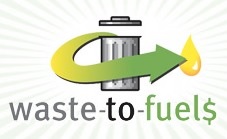
Waste to Fuel: How to Create a Win-Win-Win Scenario
When rubbish is removed from your kerb or business, there are a variety of ways that recyclable material gets converted into other products. One energy source that people are less acquainted with is biomass and bio-fuels. Bio-fuels are derived from biomass in a process called pyrolysis whereby biodegradable matter is heated to high temperatures, separating solids, liquids and gases. The usable end product from this process is known as refuse-derived fuel (RDF). The types of biodegradable matter that can be used to make RDF include wood, plastics, cardboard, and organic substances such as kitchen scraps and lawn clippings. This biodegradable rubbish is referred to as biomass.
The process of pyrolysis begins when biomass is shredded into small pieces and thoroughly dried. It is fed into a pyrolysis reactor which heats the biomass to temperatures that will break down the biomass into gases, ash, char and sometimes liquid residue. The biomass does not combust at these high temperatures because there isn't any oxygen present in a pyrolysis reactor. Once sufficiently heated, the gases are separated from the solid and liquid residue and then quickly cooled with water in a quenching tank. As the gases cool, a portion form a bio-oil, which doesn't mix with the water. The oil is finally separated from the water and stored in a holding tank and stored until is can be sold as an RDF product. The residual gases that did not become fuel are recycled back into the pyrolysis reactor to start the process again.
The char is can be used as an agricultural product since it amplifies the soil's ability to retain water and nutrients. Since char is also very high in carbon, it not only represents an opportunity to improve soil quality, but to sequester carbon as well, helping to mitigate climate change.
It is important to note that biomass can be used as a fuel itself (it is combustible after all) and converting it into a bio-fuel isn't necessary to harvest the energy within it. Both energy sources do represent different calorific energy profiles per volume or mass. Bio-fuels, the most common one being ethanol produced by energy crops, are the ideal format for transportation since they have a higher calorific value per volume. Biomass on the other hand can be burned directly in situations were efficiency isn't of key importance.
Such is the case for South Australia. Much of the waste removed from municipalities and industry surrounding Adelaide is brought to a resource recovery facility where biodegradable and combustible waste is separated and shipped to the Adelaide Brighton Cement plants. Once there, this waste-turned-fuel, is used to partially replace coal and oil to power the manufacturing of cement. This is an excellent example of industrial symbiosis, where the bi-product of industry is used as as input for another.
Biomass isn't the only contender for pyrolysis. Waste oil, such as automotive engine oil, can be converted into diesel-like fuel. It is estimated that an annual average of 24 million tons of automotive engine waste oil is produced globally. This represents a significant source of fuel energy as global oil and natural gas reserves deplete. An article published in 2014 in the IOSR Journal of Mechanical and Civil Engineering, found that this waste oil put through the pyrolysis process actually yields the same performance as diesel fuel and can be used as a substitute in diesel engines.
One of the misconceptions of burning bio-fuels and biomass is that it is equivalent to incinerating waste or burning fossil fuels. Incinerating municipal solid waste without removing non-biodegradables, such as metals and electronics, heavily increases the amount of nitrous and sulphuric oxide emissions released into the atmosphere, as well as the amount of volatile organic compounds. While there certainly are emissions associated with the burning of biomass and bio-fuels alike, those emissions represent a smaller greenhouse gas footprint than both fossil fuels and untreated municipal and industry waste.
Using biodegradable waste as a fuel, whether through combustion or pyrolysis then combustion, has so many environmental benefits. It produces almost no waste in itself and, in the case of pyrolysis, is entirely self-sufficient from a gas perspective since gases that are cannot be converted into a bio-oil are fed back into the system. In addition, one of its by-products can be used as an agricultural product. In the case of waste oil, a hazardous substance is converted into a high performing fuel. Whether biomass or bio-fuel is burned to create energy the end result is that it minimizes landfill emissions and space used all the while decreasing our dependence on fossil fuels.
So remember, rubbish removal is so much more than collecting waste and recyclables. The behind the scenes work is sophisticated and designed to maximize environmental benefits. Recovering the resources and energy within rubbish removed from society and diverted from landfills is a budding industry with a high growth potential and a vision for a cleaner, greener planet.




